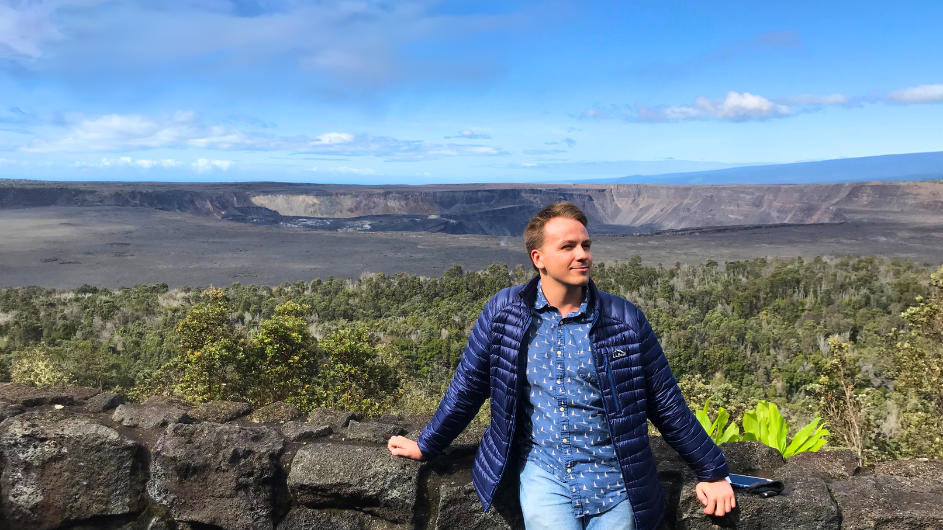Meet Columbia’s First Schwinger Fellow
Physics PhD student Ilya Komissarov talks about his theoretical work on electricity in topological materials.

Last spring, Columbia’s Physics Department received a $900,000 gift from the Schwinger Foundation, a group honoring the legacy of Columbia alum and 1965 Nobel Laureate in Physics Julian Schwinger (CC’36, GSAS’39). The gift supports, in perpetuity, research conducted by talented graduate students in physics. The Physics Department recently named the first Schwinger Fellow: Ilya Komissarov, a 6th-year physics PhD student chosen for his outstanding interdisciplinary theoretical research.
Schwinger conducted foundational work on quantum and classical field theory, nuclear physics, and many-body physics; the methods he developed underpin theoretical physics as it is practiced today. Komissarov, who is working with assistant professor of physics Raquel Queiroz, is exploring the quantum behavior of electrons in what are known as topological materials—a unique class of condensed matter that is insulating in the middle but can conduct electricity along its edges. To explore these materials, researchers must treat electrons as quantum mechanical objects, meaning as interacting waves rather than particles.
In this Q&A, Komissarov explains his research and excitement about topological materials.
Why are you interested in these materials?
Condensed matter is everywhere. Any collection of particles that strongly interact with each other becomes condensed matter. In topological materials, electrons organize in such a way that conduction may only occur along the materials’ edges, which is very remarkable. Plus, condensed matter is a field that’s super close to experimental research.
But you are not interested in conducting your own experiments?
Not after my undergraduate degree at Moscow State University. I was always interested in physics, but we had so many labs. Every Sunday, I would spend the entire night processing and analyzing data. That was enough, and I decided to become a theorist. I wanted to come to study in the US, so I spent 15 hours a day learning English for six months to pass my exams and get into grad school.
I was initially interested in cosmology and high-energy physics, but I shifted to condensed matter. I find it more exciting and easier to visualize, and I enjoy doing calculations that can apply to more tangible objects.
Tell us about some recent calculations.
Last summer, we posted my first paper with Professor Raquel Queiroz to ArXiv. We are exploring the principles that describe electrical conductivity.
If you apply an electric field to a traditional insulator, nothing happens because all the electrons are localized—that is, they stay within a given area. Conduction can only occur when electrons become delocalized and can move around.
Electrons are quantum particles—that means you can treat their behavior like waves. This is generally true both in conductors and insulators, so it is a bit counterintuitive. Nevertheless, one can still define a localization measure from the electronic waves that stays finite in an insulator.
We found a link between this localization property, calculated from the wavefunctions of the electrons in a shared, collective state, and the polarization—a response to an alternating, rather than a constant, electric field.
Not long after, some experimental groups emailed us. They wanted to check out our theoretical results experimentally, which has been very exciting. I like that it gives a really nice sense of community, that your work matters.
Are there any experimental results to report so far?
The initial experimental data has been a little bit different from our theories, so I’ve been spending some time trying to reconcile that. But that’s part of experiments: There are so many additional factors you have to take into account.
It’s important to think about the experiments that someone would do from your theoretical work. That’s something I’ve really learned from Raquel. You can’t just calculate things: you have to imagine how everything plays out in real life and how one outcome will influence another.
How do you define quantum?
For me, it’s defined by the uncertainty principle, where you cannot localize something to a specific place, so it is hard to imagine. But you can still calculate things. All electrons occupy certain states and have certain energies: If we know a set of states and energies, we can calculate the electrons’ characteristics and how they will respond to, for example, an electric field, which causes conductivity.
What might some real-world applications of this work be?
The hope is to use what we learn about the properties of topological insulators to find and classify new materials with unique electronic properties, which could someday find applications in more efficient electronic devices.
How do you spend your free time when you aren’t calculating condensed matter properties?
My girlfriend and I enjoy walking around New York and trying different restaurants.
Any favorites?
Not a restaurant, but my favorite place is Brighton Beach. There is a lot of Russian food there, and it’s a very nice beach—in the summertime.
